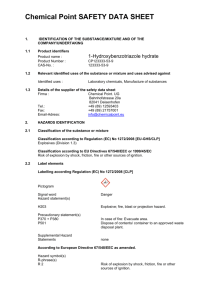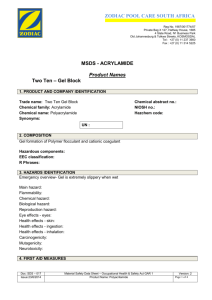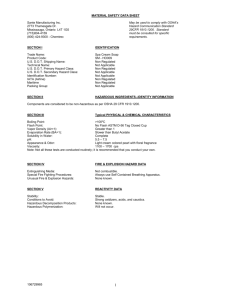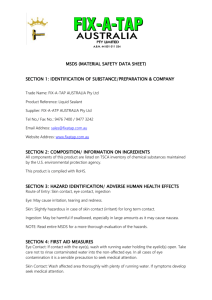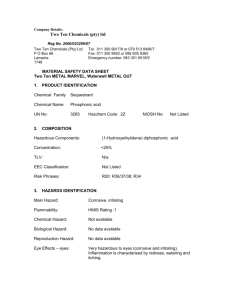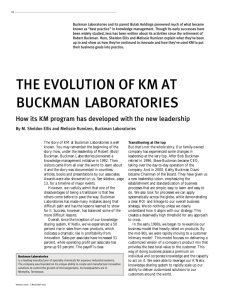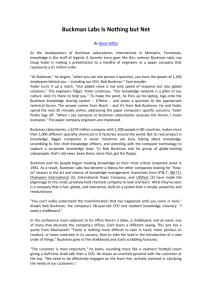product information
advertisement
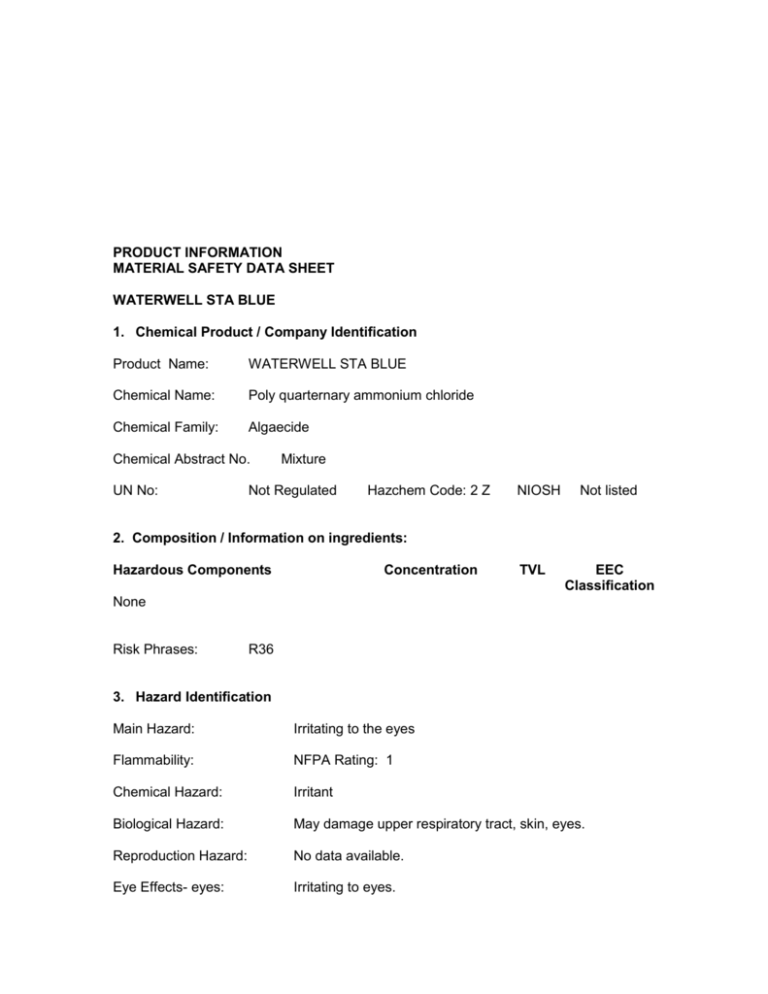
PRODUCT INFORMATION MATERIAL SAFETY DATA SHEET WATERWELL STA BLUE 1. Chemical Product / Company Identification Product Name: WATERWELL STA BLUE Chemical Name: Poly quarternary ammonium chloride Chemical Family: Algaecide Chemical Abstract No. UN No: Mixture Not Regulated Hazchem Code: 2 Z NIOSH Not listed 2. Composition / Information on ingredients: Hazardous Components Concentration TVL EEC Classification None Risk Phrases: R36 3. Hazard Identification Main Hazard: Irritating to the eyes Flammability: NFPA Rating: 1 Chemical Hazard: Irritant Biological Hazard: May damage upper respiratory tract, skin, eyes. Reproduction Hazard: No data available. Eye Effects- eyes: Irritating to eyes. Health Effects – skin: May cause mild irritation on the skin. Health Effects – ingestion: May be harmful. No data is available on human exposure. Health Effects – inhalation: May cause irritation to mucous membranes and the lungs. Carcinogenicity: Mutagenicity: Neurotoxicity: Refer Section 11 : Toxicological Information Refer Section 11 : Toxicological Information Refer Section 9 : Physical and Chemical Properties 4. First Aid Measures Product in the eye: Flush immediately with copious amounts of tap water or normal saline solution for a minimum of 15 minutes. Take exposed individual to a physician, preferably an opthalmologist, for further evaluation. Product on the skin: Wash exposed area with plenty of water. Repeat washing. Remove contaminated clothing and wash thoroughly before re-use. If irritation persists, consult a physician. Product ingested: DO NOT INDUCE VOMITING: Rinse with copious amounts of water or milk first. Irrigate the oesophagus and dilute stomach contents by slowly giving one 910 or two (2) glasses of water or milk. Avoid giving alcohol or alcohol related products. In cases where the individual is semicomatose, comatose or convulsing, DO NOT GIVE FLUIDS BY MOUTH. In case of intentional ingestion of the product, seek medical assistance immediately; take individual to nearest medical facility. Inhalation: If exposure by inhalation is suspected, immediately move exposed individual to fresh air. If individual experiences nausea, headache, dizziness, has difficulty in breathing or is cyanotic, seek medical attention immediately. NOTE TO PHYSICIAN; No product specific antidote is known. Probable mucosal damage may contraindicate the use of gastric lavage. Treat symptoms. For specialist medical advice in the event of an emergency contact 031-560 5288. 5. Fire Fighting Measures Extinguishing Media: Water fog, carbon dioxide, foam, dry chemical powder. Special Hazards: None known Protective clothing: Body-protective clothing 6. Accidental Release Measures Personal Precautions: Rubber gloves and safety glasses or goggles required. Eye wash fountains in the work place are strongly recommended. Body-protective clothing and shoes are recommended. Environmental Precaution: Do not discharge concentrated, undiluted product into lakes, streams, ponds, estuaries, oceans and other waters. Spills: Liquids: Dam area to prevent spill from spreading. Clay, soil or commercially available absorbents may be used to recover any material that cannot be recovered as pure product. Liquids/Solids/Powder: Minimise adverse effects on the environment. Recover as much as possible of the pure product into appropriate containers. Later, determine if this recovered product can be used for its intended purpose. Dispose of in an approved landfill. 7. Handling and Storage Suitable Material: Handling/Storage Precautions: The concentrated product can be handled and stored in stainless steel, aluminium, and most plastic materials of construction. The handling precautions for this product are based on the characteristics of the neat product unless otherwise specified. Store in a cool dry place. Rubber gloves and safety goggles are required. Body-protective clothing and safety shoes are required. Eye-wash fountains in the work place are strongly recommended. 8. Exposure Controls / Personal Protection Occupational Exposure Limits: None Engineering Control Measures: Provide adequate ventilation in the work place. Personal Protection – Respiratory: Use respiratory protection where misting may occur. Personal Protection – Hand: Rubber gloves Personal Protection – Eye: Safety goggles are required. Personal Protection – Skin: Body-protective clothing and safety shoes are recommended. Where splashing can occur, a protective face-shield is required. Other Protection: Eye wash fountain in the workplace is strongly recommended. 9. Physical and Chemical Properties Appearance: Odour: PH: Boiling Point: Melting Point: Flash Point: Flammability: Autoflammability: Explosive properties: Oxidising properties: Vapour Pressure: Density: Solubility in Water: Solubility-solvent Solubility Coefficient Neurotoxicity Pale yellow liquid Slight 4.0 – 7.0 (1% soln.) >100C Not available 100C (Tagliabue C.C.) NFPA Rating: 1 Not available Not available Not available Not available 1.18 – 1.20 g/ml Completely soluble in water Not available Not available Not available 10. Stability and Reactivity Conditions to avoid: Stable under normal conditions of use and storage. Incompatible materials: Anionic Polymers Hazardous decomposition products: Carbon monoxide may be released on burning 11. Toxicological Information Acute Toxicity: Oral LD50 :1 865 mg/kg Dermal LD50 : > 2 000 mg/kg Skin and Eye Contact: Irritating to eyes Chronic Toxicity The effects of chronic exposure have not been evaluated Carcinogenicity: Not listed in any of OSHA standard, section 1910.1200 sources as carcinogenic. Not tested by Buckman Laboratories, Inc. Mutagenicity: No data available Reproduction Hazard: No data available 12. Ecological Information Aquatic Toxicity – Fish: 96 Hr. LC50 : Bluegill sunfish = 0.28 mg/L ; 96 Hr. LC50: Rainbow trout = 0.0709 mg/L Aquatic Toxicity: No data available Aquatic Toxicity – algae No data available Avian Toxicity: No data available Biodegradability: Not tested by Buckman Laboratories Bio-Accumulation: Not tested by Buckman Laboratories Mobility: Not tested by Buckman Laboratories German wgk: 1 = low hazard to waters 13. Disposal Considerations Disposal Method: Dispose in accordance with local/national Regulations governing the disposal of waste materials. Disposal of Packaging: Dispose of drums through a registered drum reconditioning company. Dispose of packaging other than drums, e.g. Flexi-bags, through a registered waste disposal company in an approved landfill. 14. Transport Information UN No.: Substance Identity No.: Dot Class ADR/RID Class: ADR/RID Item Number: Not Regulated Not Regulated Not Regulated Not Regulated Not applicable ADR/RID Hazard Identity Number: IMDG – Shipping Name: IMDG – Page: IMDG – Class: IMDG – Packaging Group: IMDG – Marine Pollutant: EMS No.: MFAG Table No. : IATA – Shipping Name: IATA – Class: IATA – Subsidiary risk(s): ADNR – Class UK – Description: UK – Emergency Action Class: UK – Classification: Tremcard No.: Not applicable Not applicable Not applicable Not Regulated III Not available Not applicable Not applicable Not applicable Not Regulated None Not Regulated Not applicable Not Regulated Not Regulated BSN1055 15. Regulatory Information EEC – Hazard Classification: Not Listed Risk Phrases: R36 Safety Phrases: S26 National Legislation: None known FDA Approvals: 176.170 16. Other Information There is no other information available The information on the Material Safety Data Sheet reflects the latest information and data that we have on hazards, properties, and handling of this product under the recommended conditions of use. Any use of this product or method of application which is not described in the Product Data Sheet is the responsibility of the user. Revision No : MSDS – 05 20 May 2002
